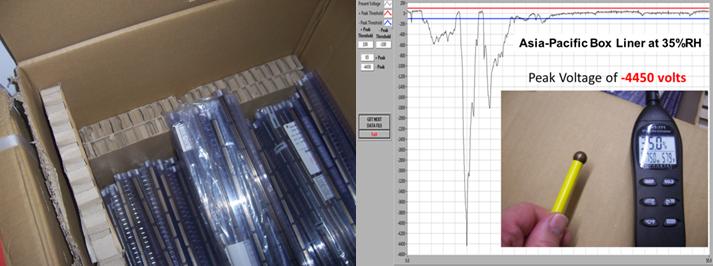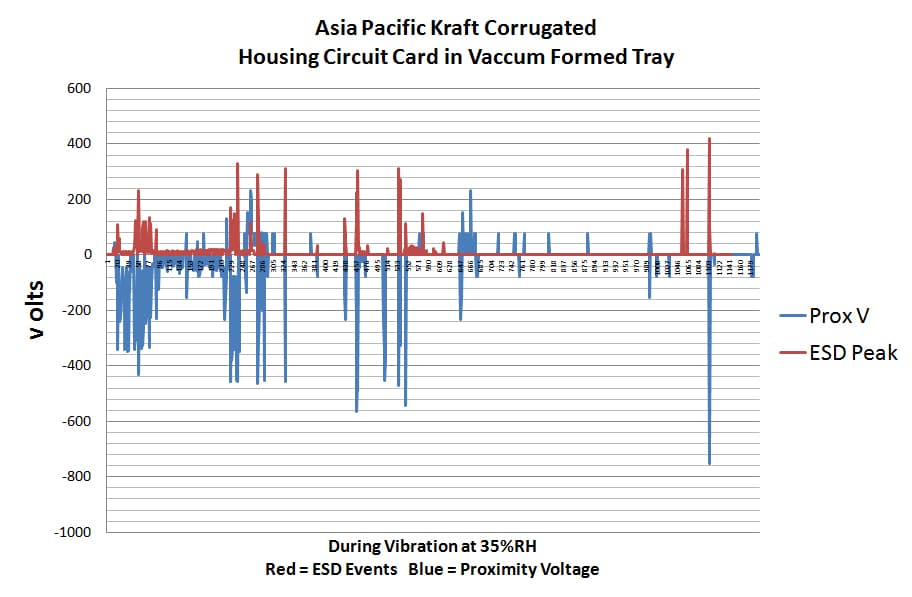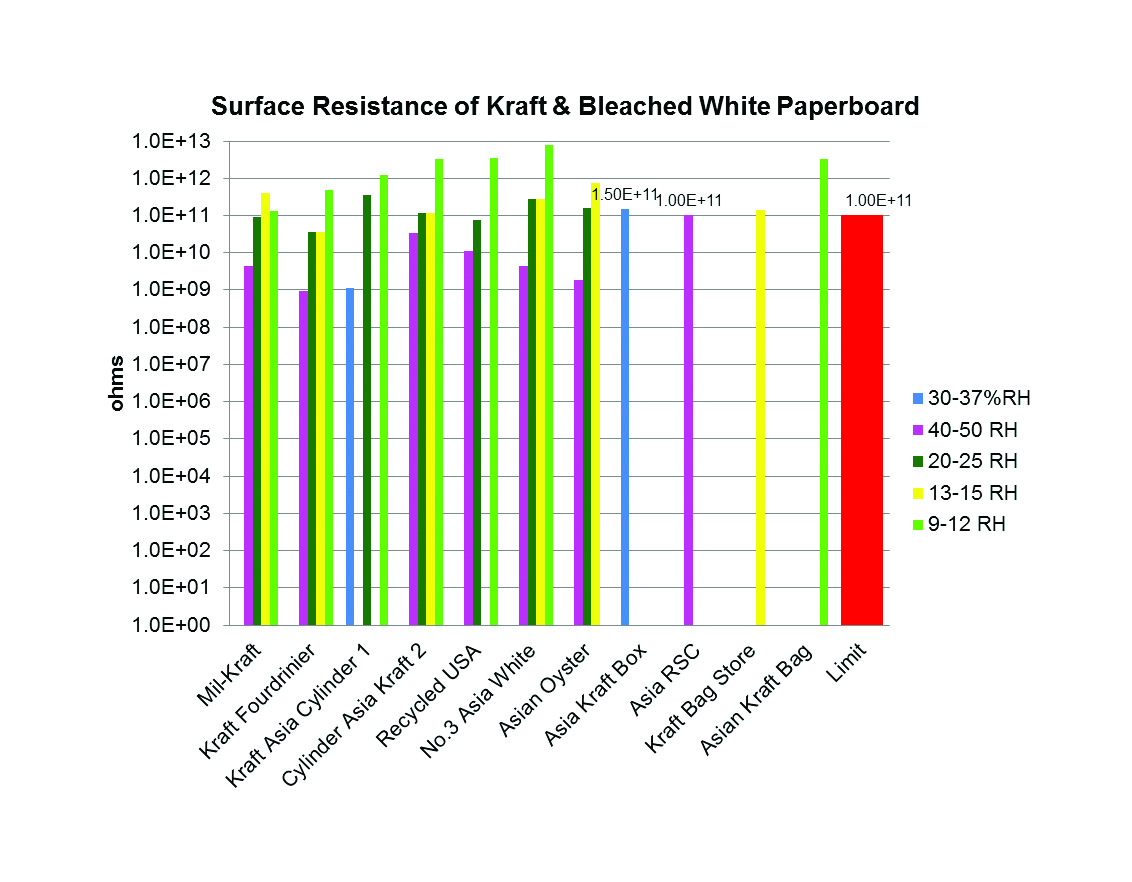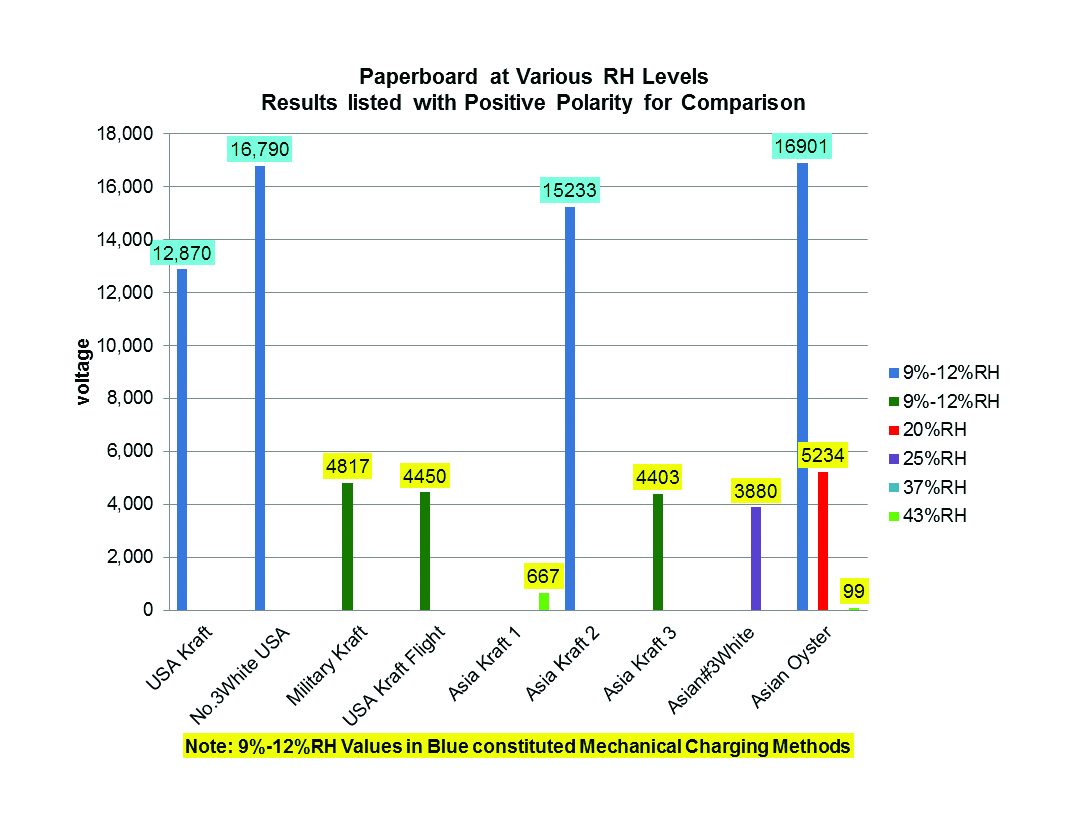Bob Vermillion, CPP/Fellow
Certified ESD & Product Safety Control Engineer-iNARTE
RMV Technology Group, LLC
NASA-Ames Research Center
Moffett Field, CA 94035
Several years ago, Ray Gompf, Ph.D., PE (Ret.), NASA, Kennedy Space Center and the author evaluated 7” x 7” ESD corrugated, Kraft and bleached B-Flute corrugated substrates for Tribocharge Generation at low relative humidity (RH). At 45% RH, all samples generated peak voltages of less than 100 volts. However, Kraft corrugated at 12%RH peaked out at 12,870 volts. The Number 3 Bleached White liner generated 16,790 volts.

During transport and shipping, RH conditions can reach to less than 4% representative of winter months in Colorado or Santa Ana Wind conditions in California. In flight, the relative humidity of the aircraft cabin dropped from 60%RH to 9.33% after 20 minutes (Figure 1). The 7” x 7” sheet of Kraft corrugated charged to -4,403 volts. Before takeoff, this same sheet charged to less than 10 volts.
Traditionally, the author’s field measurements in electrostatic discharge (ESD) safe areas between 30% RH to 70% RH have produced corrugated paperboard reading at less than 100 volts. However, recent on-site testing of Asia-Pacific sourced Cylinder Machine corrugated liner, produced results in excess of 100 volts.
USA grades of Kraft corrugated linerboard have moisture contents of approximately 5% to a high of about 9%; Oyster White, number 1 and 3 white liners can range from 6% to 7%. Corrugated medium can have a moisture content of 5% to 7%. Moisture insures elasticity of paper as problems can occur at <5%.
Many USA & EU Integrated paper companies that have abundant forestlands, paper mills and box conversion capabilities employ a Fourdrinier papermaking process patented in 1801 by John Gamble. Fourdrinier paperboard is a homogenous admixture of wood pulp, fiber, water and other additives with aligned moisture retaining wood fiber for strength.

Most of the Asia-Pacific forestlands have long been depleted. The Cylinder Machine papermaking process (invented by John Dickinson in 1809) produces a multi-layered corrugated liner sheet consisting of newsprint, rags, bamboo, recycled corrugated containers and other products. Therefore, lack of moisture containing virgin wood fiber can run the risk of producing charge generating paperboard.

The Fourdrinier process insures higher moisture content of paperboard enabling Kraft linerboard to be more conductive from 15%RH toAt 40%RH in comparison to the same liner subjected to 12%RH conditioning, resistance testing constitutes one method in differentiating whether the paperboard contains adequate moisture. Corrugated linerboard moisture content at 5% or more insures insure a greater likelihood of being low charging. Therefore, there is a relationship between Surface Resistance and Relative Humidity as illustrated in Table 1.
According to the late John Kolyer, Ph.D. (Boeing, Retired) in his book ESD from A to Z , surface resistance of humidity dependent materials rises and falls when RH fluctuates.
Note: ANSI/ESD S541 lists 1.0 x 1011 ohms as the standard cutoff for retention of static dissipative properties. In practice, however, a lower cut-off is often desired for packaging materials since dry air may be encountered in shipping and handling. In cold and dry climactic conditions, relative humidity can reach 4% or below. In Figure 3, the reader will observe a Kraft paper grocery bag charging to -4,970 and 2,403 volts at 13%RH.

Since the mid-1990s, the author has presented on the effects of paper charging. Moreover, recent on-site assessments by the author have identified Asia-Pacific Cylinder Machine paperboard as a significant charge source at moderate RH levels.

In Figure 5, left, the Fourdrinier liner is abundant in wood chips while the Cylinder liner (right, photograph) is layered and contains recycled paperboard, ink pigments, extraneous fiber and other unknown content.

At 20%RH, the Asia-Pacific Oyster White Cylinder paper measured in the insulative range at 1.6 x 1011 ohms and 5,234 volts. At 9%RH, the voltage was 16,901 volts. In contrast, at 43%RH, the same Oyster White Lock Front Mailer measured 1.9 x 109 ohms and produced 99 volts. Another risk to an organization is the Incoming Receiving Department practice of transferring ESD sensitive devices from charge generating corrugated containers (without the use of ionization). This represents a hazard to ESD sensitive devices at a distance of less than one (1) foot.

During RFID placement (Figure 7), the tags can be incorrectly positioned representing another risk. Oftentimes, corrugated containers can travel down a conveyor in an “upside down” position so that a RFID tag ends up on the new bottom of a box. The tag then passes between two or more steel rollers at the instant when one of the rollers generates an ESD event (between its shaft and the side rail). Arguably, the thought is that corrugated containers can be placed on ESD workstations with an assumption that the packaging will not harm ESD sensitive devices above 30%RH. One must consider paperboard charging. For instance, Asia-Pacific Cylinder Machine linerboard charged to -4,450 volts at 35%RH as illustrated in Figure 8. The NASA Workmanship NASA-STD 8739.6 on page 16 sets Temperature and Relativity levels in section 6.1 18° – 30° C (65° – 85° F) and a maximum relative humidity of 70 percent. For ESD-sensitive hardware, the minimum humidity is 30%RH. For Human Body Model (HBM) Class 0 ESD sensitive devices (<250 volts), the minimum RH level is 40%.

The IC Carriers (Dip Tubes) that house ESD sensitive devices were not protected by a static shielding of RFI/EMI attenuating Moisture Barrier Bags (MBB) in Figure 8. Consequently, charge generation during transport causes ESD events when the relative humidity falls below 25%RH to 30%RH. During transport, Asia-Pacific, USA and EU Fourdrinier and Cylinder Machine Paper will charge at 9%RH. The reader can observe simulation testing at low RH for a corrugated bulk container that generated hundreds of electrostatic field voltages (Prox V) and discharges (ESD Peak – Voltage). The field induced model (FIM) discharges would most likely damage ESD sensitive devices if shielding precautions were not implemented.

Therefore, at first glance, Table 2 indicates that Asia-Pacific Cylinder paperboard has a tendency to generate static electricity at higher RH levels than USA and EU Kraft and bleached liner.
In short, further work in this area will be conducted to build a case history for comparison between Asia-Pacific Cylinder Machine corrugated versus EU and USA Fourdrinier grades of paperboard. Cylinder Machine paperboard from the Asia-Pacific region has a greater tendency to charge generate than Fourdrinier produced corrugated linerboard manufactured in both the US & EU.
About the Author
Bob Vermillion is a Subject Matter Expert in ESD mitigation of Material & Packaging and is an ESDA Standards Committee Member. Bob was the First to Identify and Present on Suspect Counterfeit ESD Packaging in the Supply Chain at the NASA-QLF in 2010. RMV is located on-site at NASA-Ames Research Center. Bob publishes numerous articles and white papers on advanced materials, packaging non-compliance and suspect counterfeiting in manufacturing, materials handling, shipping and long-term storage for the aerospace/defense, medical and electronics sectors. Speaking engagements include invitations from the DOD, DOE and NASA to present on Supplier Issues with Materials and Packaging. RMV is a NASA approved ESD Laboratory at NASA-Ames. An internationally recognized Author and Inventor, Bob developed professional level ESD Packaging Seminars for Cal Poly, SJSU, UC Berkeley, Loyola Marymount, Clemson University and Oxford University. RMV is a 3rd Party ESD Material Testing, Training and Consulting Company. Bob Vermillion is an active member of SAE G-19 Counterfeit Components and SAE G-21Counterfeit Materiel Committees. Bob can be reached at 650.964.4792 or email Bob at bob@esdrmv.com.
References
ANSI/ESD S541, ESD Packaging & Materials Standard
ESD from A to Z, Second Edition, Kolyer & Watson, Chapman & Hall, 1996
Humidity & Temperature Effects on Surface Resistivity
John Kolyer and Ronald Rushworth
Evaluation Engineering, October 1990, pp. 106-110
Packaging’s Fight Against ESD (RFID)
Doug Smith and Bob Vermillion
Medical Device-network.com, March 2010
Military Handbook-263-A, 22 February 1991/2 May 1980, p. 46
Tribocharging Test, NASA, Kennedy Space Center, Ray Gompf, Ph.D., PE
RMV Charge Generation Testing, NASA-Ames Research Center, Moffett Field, CA
RMV Resistance Testing, NASA-Ames Research Center, Moffett Field, CA







